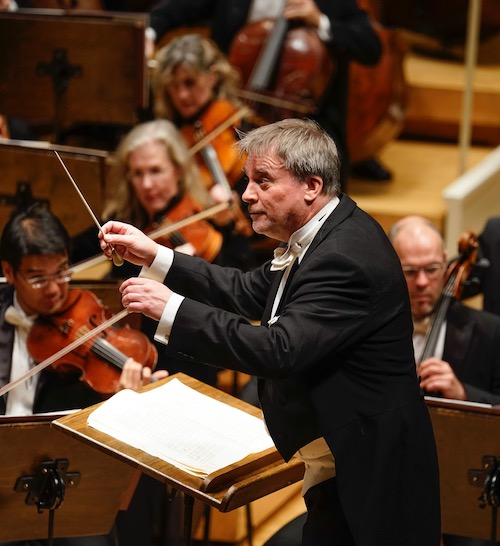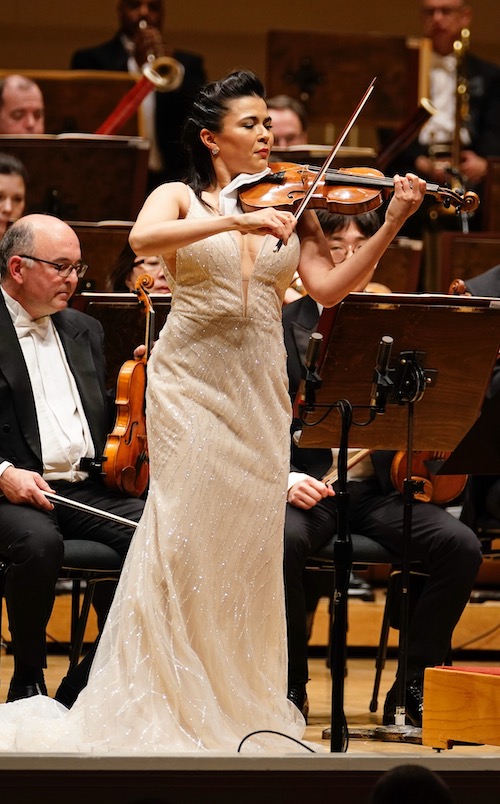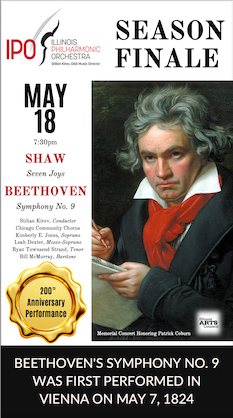Storgårds returns to CSO with impressive results, from Glass to Rachmaninoff

John Storgårds has directed some worthy performances in his previous Orchestra Hall appearances (in 2017 and 2019). On Thursday night, the Finnish conductor returned in his most impressive local stand to date, leading the Chicago Symphony Orchestra in a nicely balanced trio of works that provided consistently compelling results. It’s too bad there were so many empty seats for such a varied and enjoyable program.
The evening led off with music of the conductor’s greatest composer compatriot, Jean Sibelius. In addition to his seven symphonies and Violin Concerto, Sibelius wrote several shorter orchestral works based on Finnish folklore from the national epic, the Kalevala. Among these is the tone poem Pohjola’s Daughter.
The hero Väinämöinen is entranced by the title maiden who sets him a series of improbable tasks to win her, including tying an egg into invisible knots. Some relationships reach a point of diminishing returns quicker than others. Väinämöinen soon admits defeat and slinks off to his next adventure.
The scenario may be typical mythic folderol, but the music is magnificent—masterfully scored for large orchestra (Sibelius originally planned Pohjola’s Daughter as a symphony) and characteristic in its restless drama and Northern sensibility.
Storgårds led a richly atmospheric reading that sounded wholly idiomatic from the jump. John Sharp’s dark-hued opening cello solo seemed to arise from somewhere deep within the Finnish soil, and the ensuing lowing winds (bass clarinet and contrabassoon) were eerie and evocative. This is tricky music, restless and mercurial in nature. Yet every tempo shift, dynamic leap and timbral change emerged naturally under Storgårds’ baton—the expectant tension in the pizzicato section, the evocative clarinet solo by guest principal Todd Levy (Milwaukee Symphony) and the shrieking strings. The penultimate section built to a daunting brass peroration against emphatic angular violins before the tempo slowed into a hushed coda. The gradual ebbing away of the strings to silence was expertly guided and beautifully played by the musicians.
This week’s concerts were supposed to present the world premiere of Indigo Heaven, a new concerto by Christopher Theofanidis, commissioned by the CSO for principal clarinetist Stephen Williamson. Unfortunately—and as regular concertgoers will have noted—Williamson has been absent from the CSO active roster since the start of the season in September, due to his recovery from unspecified surgery.
The Theofanidis concerto has been moved to the 2024-25 season. More importantly, CSO sources said this week that Williamson will be back in his chair before the end of the year, which is good news for CSO audiences.
While it’s disappointing that the premiere has been delayed, the CSO came up with an engaging bit of alternative programming in its stead with Philip Glass’s Violin Concerto No. 1, heard in its belated Orchestra Hall debut.
After having ignored Philip Glass almost completely for over 50 years, the CSO has recently been making up for lost time. Riccardo Muti, to his credit, led Glass’s Symphony No. 11 last year, a performance that has been released on the CSO’s Resound label. The orchestra commissioned its first work by Glass, The Triumph of the Octagon, which Muti debuted this fall and took on tour to Carnegie Hall. This week’s concerto performance continues the CSO’s late but welcome Glass renaissance.
The Violin Concerto No. 1 is a crucial road-marker amid Glass’s dizzyingly prolific output. Though he found early renown with his eponymous ensemble and then as an opera composer, this 1987 concerto was the work that sparked Glass’s turn to writing for full orchestra. He continues to compose in other genres as well, yet the orchestra has received much of his focus, with 14 symphonies and as many concertos to date, plus more than two-dozen other works.
While Glass’s symphonic writing has become more layered and sophisticated in the ensuing 36 years, the Violin Concerto gives us the composer’s essential qualities at their most unadorned and communicative—a relentless, pulsing rhythmic impetus and rock-like energy allied to a surprisingly tender lyricism.

Karen Gomyo proved a mixed proponent of Glass’s score. The soloist was at her best in the more expressive pages, with her refined, elegant tone well suited to the spare passages of the central movement and, especially the closing section of the rollicking finale, where the music slows down and the soloist ruminates inwardly.
Gomyo was less successful in the main body of the framing movements. Though she handled Glass’s arpeggiated bursts with admirable polish, her light violin tone sounded pallid and even wispy, too often failing to project with sufficient body out into the hall. In the hard-charging finale, she was at times nearly inaudible and often buried by Glass’s rambunctious percussion. This was not a fault of balancing by Glass or the conductor but of insufficient projection from the soloist.
After some initial lack of rhythmic precision, Storgårds’ accompaniment largely had Glass’s individual style in hand. The conductor and orchestra provided Gomyo with alert and spirited support, with Storgårds drawing out the contemplative final section in a structurally convincing fashion.
The CSO has done an admirable job of marking this 150th anniversary of Sergei Rachmaninoff’s birth, giving us the Third Piano Concerto, Rhapsody on a Theme of Paganini, Second Symphony and Symphonic Dances.
This week’s program brings the last Rachmaninoff 150 item of 2023 with the Russian composer’s Symphony No. 3. (It would have been nice to hear the composer’s strange yet compelling First Symphony as well, which was not included in this year’s lineup.)
Rachmaninoff’s Third Symphony is his final work in the genre, and a leaner, more edgy and less richly Romantic work than its predecessor or the best of his concertos, with material not as profuse nor as indelible. The exception is the second theme of the opening movement, a rich yearning melody for cellos that is well mined by the composer throughout the first movement.
Thursday night’s performance did not begin auspiciously with a spindly horn solo by principal Mark Almond and Storgårds’ lumbering initial tempo dragging the main theme. Things began to get on track as the music unfolded; the conductor elicited a burnished rendering by the cello section of their arching theme, all the more effective for its understatement.
Storgårds drew a weighty, echt-Russian sonority that was tensile and firmly focused with dramatic punch. The central Adagio benefited by expressive solo horn and flute contributions by Almond and Stefán Ragnar Höskuldsson, respectively. Storgårds pointed up contrasts effectively in this rhapsodic music, the lyrical repose setting up the high-strung fervor of the middle section.
Lesser hands tend to whip up the symphony’s finale into a raucous frenzy of speed and volume. Storgårds led a performance that had ample excitement yet avoided going over the top, maintaining the main theme’s essential ebullience. He gave ample attention to the alternating sections—more fine work by clarinetist Levy here—and that patience added cumulative ballast to the musical narrative. When the tumultuous final bars were reached, the effect was exhilarating and a true climax with Storgårds letting the players cut loose in the race to the finish line and thunderous final bars.
The program will be repeated 1:30 p.m. Friday and 7:30 p.m. Saturday. cso.org
Posted in Uncategorized




